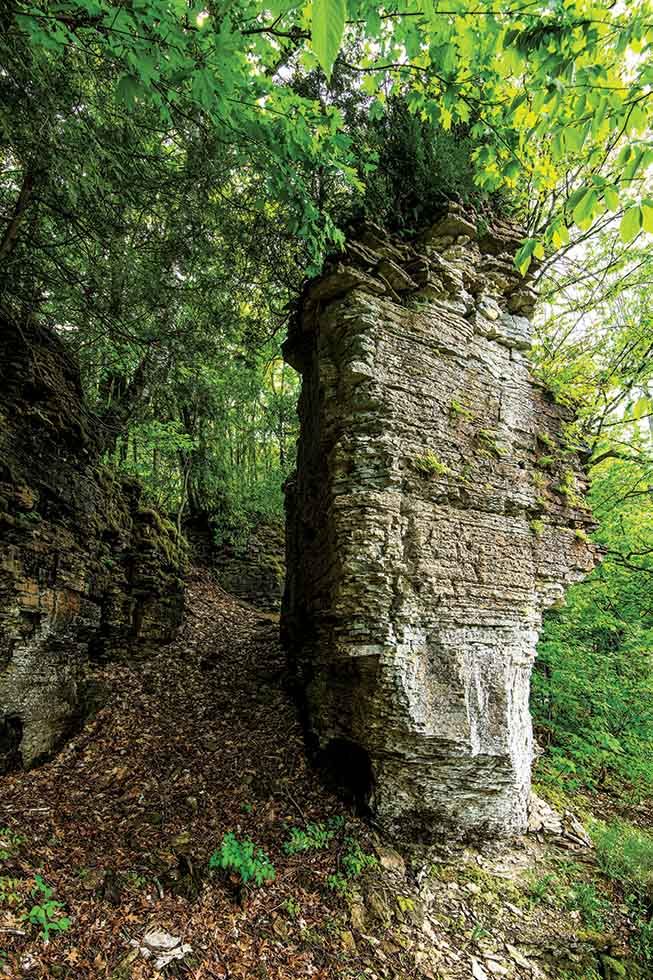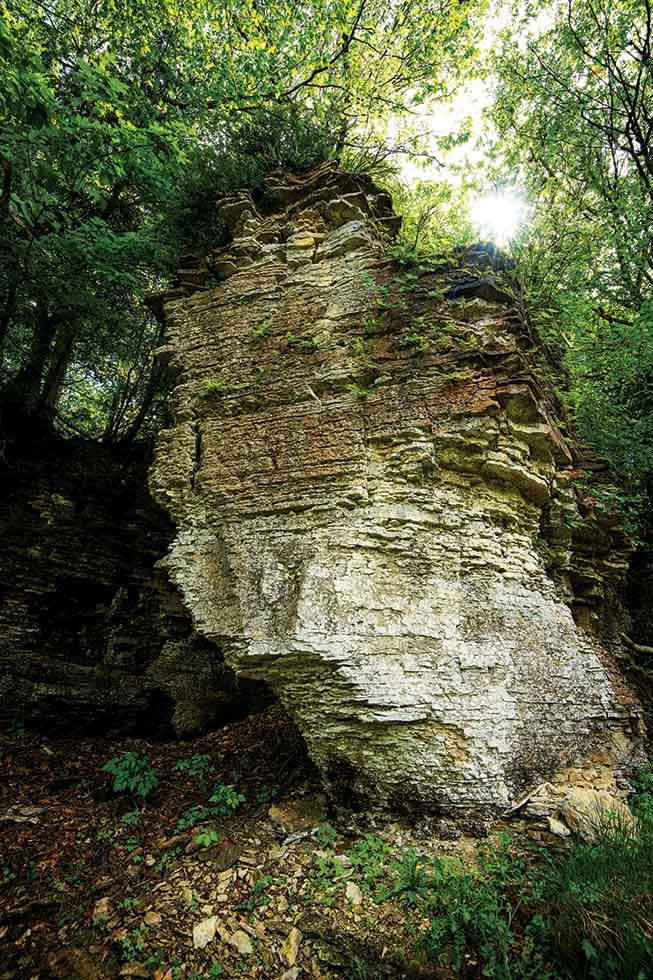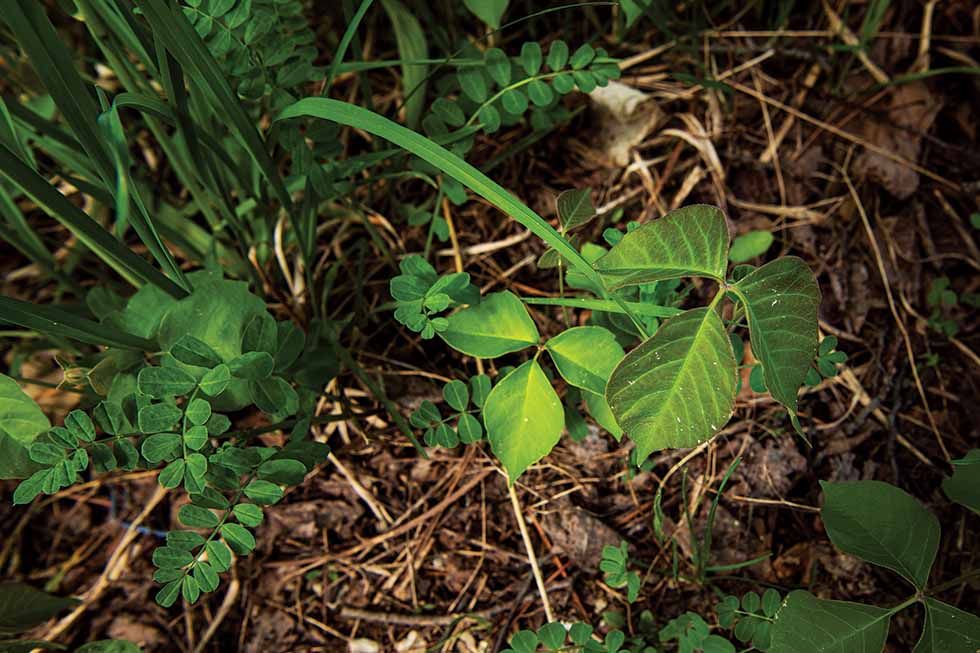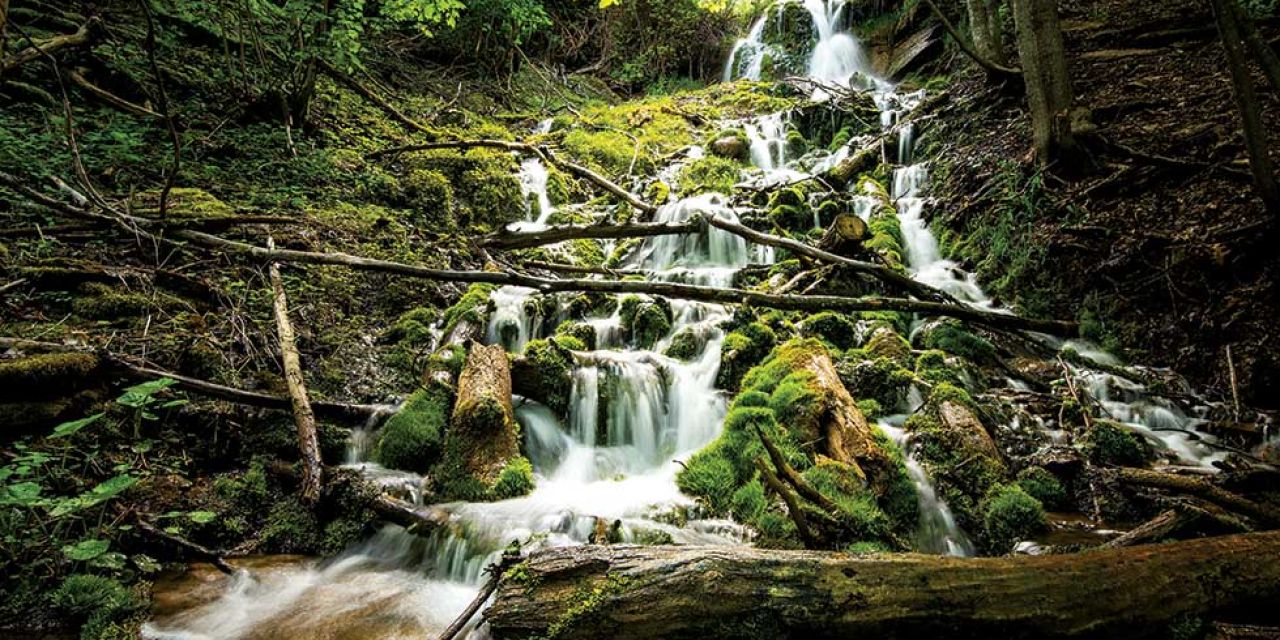Cascade waterfall, at the top of the Cascade Trail, Blue Mountain Resort.
The Scenic Route
by Cara Williams | photography by Clay Dolan
While hiking at Blue Mountain Resort, trekkers can expect to hike through ancient limestone cliffs, past fossilized marine life, and alongside stunning waterfalls, all while enjoying breathtaking views.
You may already know that Blue Mountain Resort offers over 30 kilometres of hiking trails just begging to be explored, but did you know that this natural playground is also a geological marvel? The Niagara Escarpment, a UNESCO World Biosphere Reserve, forms the backbone of the resort. Its dramatic cliffs and ancient outcrops reveal a geological history spanning millions of years, with fossilized remnants of marine life providing a glimpse into the distant past when the area was submerged under a shallow sea. The distinctive blue-grey shale layers contribute to the unique hue of the Blue Mountains (hence the name). The hiking trails suit all skill levels, offering amazing views and the unique beauty of the Escarpment at every turn. Whether you’re into waterfalls, wildlife, or cool geological history, you’re in for a fun and unforgettable experience.
Near the top of the Sunnyside Up trail stand centuries old sea stacks. Often called “flowerpots”, these pillars of limestone and dolostone are shaped by erosion from prehistoric seas—while you’re here, keep an eye out for the distinctive shapes of ancient shells embedded in the rock! These formations, similar to the famous sea stacks at Flowerpot Island in Fathom Five National Marine Park, showcase the enduring impact of natural forces over millennia.


The centuries old sea stack “flowerpot” near the top of Sunnyside Up trail.
While the resort may no longer be under water, many trails run alongside picturesque creeks and streams. The cascades, fed by the area’s abundant springs, tumble over the rugged limestone cliffs of the Escarpment, creating a series of waterfalls that punctuate the lush greenery. One of the best hidden gems is Cascade waterfall, which offers a serene spot for hikers to rest and enjoy the cool mist and soothing sounds of falling water. Bonus points if you can find the lesser-known falls near the top of the Cagey trail.
Along your travels you’ll also encounter an abundance of flora and fauna, including sumac, apple trees, and raspberry canes. At the base of the Escarpment, the vibrant hues of ornamental sumacs may catch your eye. The velvety texture of their leaf petioles and the forking pattern of the branches, reminiscent of antlers, have led to their moniker, “stag’s horn sumac.” These hardy shrubs bear edible berries amidst their vibrant red clusters. Venturing further along the trails, you may stumble upon wild apple trees, offering a sweet reward for your journey. Alongside the paths, vast patches of red raspberry bushes flourish, and black raspberries can be found along the lower Grind, Sticks & Stones, and throughout the Cagey trail.

Leaves of three, let them be… Poison ivy leaves turn reddish in the spring, green in the summer and yellow, orange or red in the fall.
While in the lower Grind area, you might also encounter giant hogweed or wild parsnip. Giant hogweed can grow up to 14 feet tall with large, white umbrella-shaped flowers, while wild parsnip has yellow flower clusters. Avoid contact, as both plants are highly toxic and can cause skin irritation. As you explore the upper Village Way, look out for poison ivy, recognizable by its three shiny green leaves. But worry not—the trails are well-maintained by the team at Blue Mountain, ensuring hikers can enjoy the experience without concern for these plants as long as they stay on the marked paths.
As you hike, you’ll come across areas filled with eastern white cedars. These hardy, slow-growing trees thrive along the Escarpment cliffs, appearing almost shrub-like, twisted, and gnarled due to the harsh growing conditions. Despite their small size, some of these ancient trees could be hundreds of years old with a circumference of only a few centimetres. Their aromatic foliage adds an enchanting old-world ambiance to the trail.
Exploring the hiking trails at Blue Mountain is like stepping back in time, where the unique geology tells the story of our area’s rich ecological history. As you traverse these ancient limestone cliffs, encountering fossilized remnants of marine life, and cascading waterfalls, you’ll gain a deeper appreciation for the geological processes that have shaped the Escarpment over millennia. E










